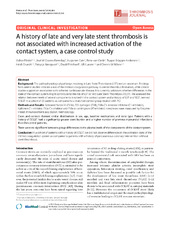| dc.contributor.author | Pönitz, Volker | en_US |
| dc.contributor.author | Govers-Riemslag, José W. | en_US |
| dc.contributor.author | Cate, Hugo ten | en_US |
| dc.contributor.author | Oerle, Rene van | en_US |
| dc.contributor.author | Brügger-Andersen, Trygve | en_US |
| dc.contributor.author | Grundt, Heidi | en_US |
| dc.contributor.author | Næsgaard, Patrycja A. | en_US |
| dc.contributor.author | Pritchard, David | en_US |
| dc.contributor.author | Larsen, Alf Inge | en_US |
| dc.contributor.author | Nilsen, Dennis W. T. | en_US |
| dc.date.accessioned | 2011-01-05T10:31:59Z | |
| dc.date.available | 2011-01-05T10:31:59Z | |
| dc.date.issued | 2010-04-15 | eng |
| dc.Published | Thrombosis Journal 2010, 8:6 | en |
| dc.identifier.issn | 1477-9560 | |
| dc.identifier.uri | https://hdl.handle.net/1956/4372 | |
| dc.description.abstract | Background: The pathophysiological pathways resulting in Late Stent Thrombosis (LST) remain uncertain. Findings from animal studies indicate a role of the intrinsic coagulation pathway in arterial thrombus formation, while clinical studies support an association with ischemic cardiovascular disease. It is currently unknown whether differences in the state of the contact system might contribute to the risk of LST or Very Late Stent Thrombosis (VLST). We assessed the relation between levels of several components involved in the contact system and a history of LST and VLST, termed (V)LST in a cohort of 20 patients as compared to a matched control group treated with PCI. Methods and Results: Activated factor XII (FXIIa), FXII zymogen (FXII), FXIIa-C1-esterase inhibitor (C1-inhibitor), Kallikrein-C1-inhibitor, FXIa-C1-inhibitor and FXIa-α1-antitrypsin (AT-inhibitor) complexes were measured by Enzyme-linked immunosorbent assy (ELISA) methodology. Cases and controls showed similar distributions in sex, age, baseline medications and stent type. Patients with a history of (V)LST had a significantly greater stent burden and a higher number of previous myocardial infarctions than the control patients. There were no significant between-group differences in the plasma levels of the components of the contact system. Conclusion: In a cohort of patients with a history of (V)LST, we did not observe differences in the activation state of the intrinsic coagulation system as compared to patients with a history of percutaneous coronary intervention without stent thrombosis. | en_US |
| dc.language.iso | eng | eng |
| dc.publisher | BioMed Central | eng |
| dc.rights | Attribution CC BY | eng |
| dc.rights.uri | http://creativecommons.org/licenses/by/2.0 | eng |
| dc.title | A history of late and very late stent thrombosis is not associated with increased activation of the contact system, a case control study | en_US |
| dc.type | Peer reviewed | |
| dc.type | Journal article | |
| dc.description.version | publishedVersion | en_US |
| dc.rights.holder | Copyright 2010 Pönitz et al; licensee BioMed Central Ltd. This is an Open Access article distributed under the terms of the Creative Commons Attribution License (http://creativecommons.org/licenses/by/2.0), which permits unrestricted use, distribution, and reproduction in any medium, provided the original work is properly cited. | |
| dc.rights.holder | Pönitz et al | |
| dc.identifier.doi | https://doi.org/10.1186/1477-9560-8-6 | |
| dc.identifier.cristin | 349370 | |
| dc.subject.nsi | VDP::Medisinske Fag: 700::Basale medisinske, odontologiske og veterinærmedisinske fag: 710 | nob |

